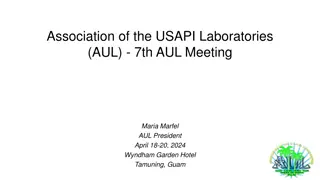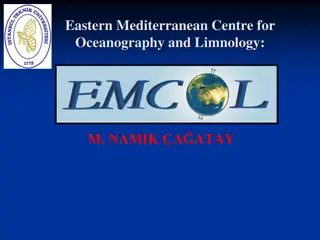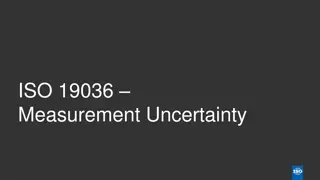Overview of Immunohistochemistry (IHC) in Diagnostic and Research Laboratories
Immunohistochemistry (IHC) is a technique used to detect antigens in tissue sections by utilizing antibodies that bind specifically to target antigens. This method has evolved since the 1930s and plays a vital role in disease diagnosis, drug development, and biological research. IHC combines anatomical, immunological, and biochemical techniques to identify specific tissue components. The process involves sample preparation, labeling, and visualization of cellular components within tissues. Applications of IHC include cancer diagnosis, tumor staging, and identifying cell types. Proper tissue collection and fixation are crucial steps in IHC procedures. Technological advancements have enabled automation of sample preparation and staining, enhancing the efficiency of IHC in laboratories.
Download Presentation

Please find below an Image/Link to download the presentation.
The content on the website is provided AS IS for your information and personal use only. It may not be sold, licensed, or shared on other websites without obtaining consent from the author.If you encounter any issues during the download, it is possible that the publisher has removed the file from their server.
You are allowed to download the files provided on this website for personal or commercial use, subject to the condition that they are used lawfully. All files are the property of their respective owners.
The content on the website is provided AS IS for your information and personal use only. It may not be sold, licensed, or shared on other websites without obtaining consent from the author.
E N D
Presentation Transcript
Immunohistochemistry (IHC): The principle of IHC has been known since the 1930s, but it was not until 1942 that the first IHC study was reported. Coons et al. (1942) used FITC-labeled antibodies to identify Pneumococcal antigens in infected tissue. Since then, improvements have been made in protein conjugation, tissue fixation methods, detection labels and microscopy, making immunohistochemistrya routine and essential tool in diagnostic and research laboratories. FITC
Immunohistochemistry (IHC) refers to the process of detecting antigens (e.g. proteins) in cells of a tissue section by exploiting the principle of antibodies binding specifically to antigens in biological tissues. IHC takes its name from the roots "immuno", in reference to antibodies used in the procedure, and "histo," meaning tissue (compare to immunocytochemistry). Immunohistochemistry (IHC) combines anatomical, immunological and biochemical techniques to identify discrete tissue components by the interaction of target antigens with specific antibodies tagged with a visible label. IHC makes it possible to visualize the distribution and localization of specific cellular components within cells and in the proper tissue context. While there are multiple approaches and permutations in IHC methodology, all of the steps involved are separated into two groups: sample preparation and labeling.
Applications IHC is used for disease diagnosis, drug development and biological research. Using specific tumor markers, physicians use IHC to diagnose a cancer as benign or malignant, determine the stage and grade of a tumor, and identify the cell type and origin of a metastasis to find the site of the primary tumor. Samples are prepared on individual slides, or multiple samples can be arranged on a single slide for comparative analysis, such as with tissue microarrays. IHC slides can be processed and stained manually, while technological advances now provide automation for high-throughput sample preparation and staining. Samples can be viewed by either light or fluorescence microscopy.
Tissue Collection : Patient or animal biopsies, or whole animal organs, are collected for preservation and IHC analysis, depending on the requirements of the assay. Tissue must be rapidly preserved to prevent the breakdown of cellular protein and tissue architecture. Often, the tissue is perfused, or rinsed of blood, prior to preservation to prevent the detection of hematologic antigens that may interfere with the detection of target antigens.
Tissue Fixation Fixation chemically crosslinks proteins or reduces protein solubility, which can mask target antigens during prolonged or improper fixation. Therefore, the right fixation method must be optimized based on the application and the target antigen to be stained. The most common fixative is formaldehyde, a semi- reversible, covalent crosslinking reagent that can be used for perfusion or immersion fixation for any length of time, depending on the level of fixation required. Other fixatives are available, and their use depends on the antigens that are being sought.
Tissue Embedding Fixed tissue samples are embedded in paraffin to maintain the natural shape and architecture of the sample during long-term storage and sectioning for IHC. Samples too sensitive for either chemical fixation or the solvents used to remove the paraffin are encased in cryogenic embedding medium and then snap-frozen in liquid nitrogen.
Sectioning and Mounting The decision to section tissue is dependent upon the application used; for example, whole mount IHC, with sample thickness up to 5 m, does not require sectioning, while small samples for which multiple staining procedures are needed may require sectioning. Formalin-fixed, paraffin-embedded tissues are sectioned into slices as thin as 4 to 5 m with a microtome. These sections are then mounted onto glass slides that are coated with an adhesive. This adhesive is commonly added by surface-treating glass slides with 3- aminopropyltriethoxysilane (APTS) or poly-L-lysine, which both leave amino groups on the surface of the glass to which the tissue directly couples. Alternatively, slides may be coated with physical adhesives, including gelatin, egg albumin or Elmer's glue. After mounting, the sections are dried in an oven or microwave in preparation for deparaffinization. Frozen sections are cut using a pre-cooled cryostat and mounted to adhesive glass slides. These sections are often dried overnight at room temperature and fixed by immersion in pre-cooled (-20 C) acetone, although the drying step is sometimes skipped depending on the target antigens and tissue used.
Epitope (Antigen) Recovery The paraffin from formalin-fixed, paraffin-embedded sections must be completely removed for the antibodies to reach the target antigens. Xylene, a flammable, toxic and volatile organic solvent is commonly used to remove the paraffin from IHC slides, although commercial alternatives are available. Formaldehyde fixation generates methylene bridges that crosslink proteins in tissue samples; these bridges can mask antigen presentation and prevent antibody binding. Formalin-fixed, paraffin-embedded sections commonly require a treatment to unmask the antibody epitopes, either by heat (heat-induced epitope retrieval; HIER) or enzymatic degradation (proteolytic-induced epitope retrieval; PIER).
Immunohistochemical staining is widely used in the diagnosis of abnormal cells such as those found in cancerous tumors. Specific molecular markers are characteristic of particular cellular events such as proliferation or cell death (apoptosis). Immunohistochemistry is also widely used in basic research to understand the distribution and localization of biomarkers and differentially expressed proteins in different parts of a biological tissue. Visualising an antibody-antigen interaction can be accomplished in a number of ways. In the most common instance, an antibody is conjugated to an enzyme, such as peroxidase, that can catalyse a colour-producing reaction. Alternatively, the antibody can also be tagged to a fluorophore, such as fluorescein or rhodamine
Antibody types The antibodies used for specific detection can be polyclonal or monoclonal. Polyclonal antibodies are made by injecting animals with the protein of interest, or a peptide fragment and, after a secondary immune response is stimulated, isolating antibodies from whole serum. Thus, polyclonal antibodies are a heterogeneous mix of antibodies that recognize several epitopes. Monoclonal antibodies show specificity for a single epitope. For immunohistochemical detection strategies, antibodies are classified as primary or secondary reagents. Primary antibodies are raised against an antigen of interest and are typically unconjugated (unlabelled), while secondary antibodies are raised against immunoglobulins of the primary antibody species. The secondary antibody is usually conjugated to a linker molecule, such as biotin, that then recruits reporter molecules, or the secondary antibody itself is directly bound to the reporter molecule.
IHC troubleshooting In immunohistochemical techniques, there are several steps prior to the final staining of the tissue antigen, and many potential problems affect the outcome of the procedure. The major problem areas in IHC staining include strong background staining, weak target antigen staining and autofluorescence. Endogenous biotin or reporter enzymes or primary/secondary antibody cross- reactivityare common causes of strong background staining, while weak staining may be caused by poor enzyme activity or primary antibody potency. Furthermore, autofluorescence may be due to the nature of the tissue or the fixation method. These aspects of IHC tissue prep and antibody staining must be systematically addressed to identify and overcome staining issues
https://upload.wikimedia.org/wikipedia/commons/thumb/1/15/Kidney_cd10_ihc.jpg/220px-Kidney_cd10_ihc.jpghttps://upload.wikimedia.org/wikipedia/commons/thumb/1/15/Kidney_cd10_ihc.jpg/220px-Kidney_cd10_ihc.jpg Immunohistochemical staining of normal kidney with CD10.
ATR in Human Ovarian Cancer Tissue. ATR was detected in immersion fixed paraffin-embedded sections of human ovarian cancer tissue using Goat Anti-Human ATR Antigen Affinity-purified Polyclonal Antibody (Catalog # AF4717) at 5 g/mL overnight at 4 C. Tissue was stained using the Anti-Goat HRP-DAB Cell & Tissue Staining Kit (brown; Catalog# CTS008) and counterstained with hematoxylin (blue). Specific staining was localized to nuclei in cancer cells. View our protocol for Chromogenic IHC Staining of Paraffin-embedded Tissue Sections.
Immunohistochemistry-Paraffin: Somatostatin Receptor 2 Antibody [NB300-157] - IHC staining of Somatostatin Receptor 2 in mouse pancreas using DAB with hematoxylin counterstain.
section in human colon carcinoma by chromogenic IHC (cytokeratin18 antibody )
Detection of HDAC4 in human skin by IHC. Chromogenic IHC was performed on thin sections of human skin obtained from biopsies. The sections were stained either with a rabbit polyclonal antibody against HDAC4 (Cat. No. PA1-863) or without this antibody (the negative control). HDAC4 detection was performed using a biotinylated anti-rabbit IgG secondary antibody and streptavidin-Horseradish peroxidase (HRP), followed by colorimetric detection using DAB. The sections were then counterstained with hematoxylin and mounted under coverslips. In the left hand panel, above the HDAC4 antigen is stained brown by the precipitated DAB reaction product. The control section on the right is not stained brown because no anti-HDAC4 primary antibody was used. Only the blue hematoxylincounterstaining can be seen.
IHC detection of cytokeratin 18 in human colon carcinoma tissue by immunofluorescence. The sections were incubated with a biotinylated anti-cytokeratin 18 antibody and then detected using a Thermo Fisher streptavidin-DyLight 633 conjugate (Cat. No. 21844, red fluorescence). Thermo Fisher Hoechst stain (e.g. Cat. No. 33342) was used to counterstain the cell nuclei (blue fluorescence).























